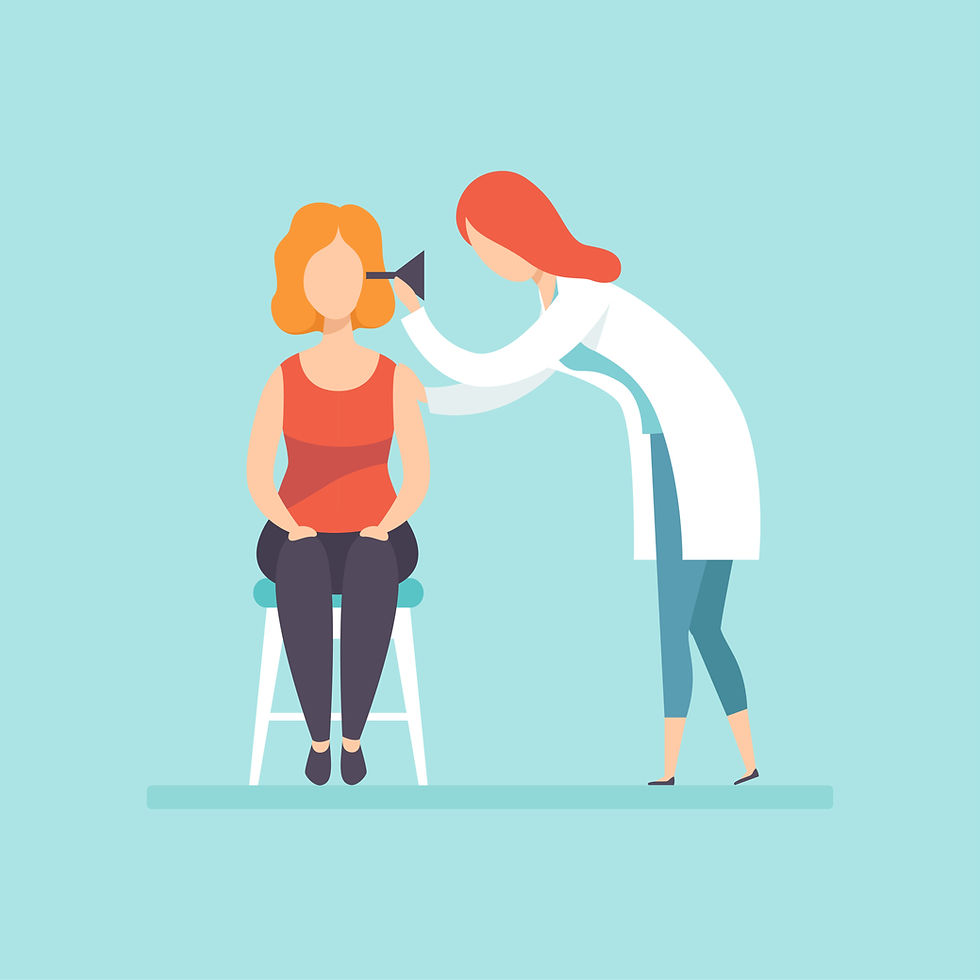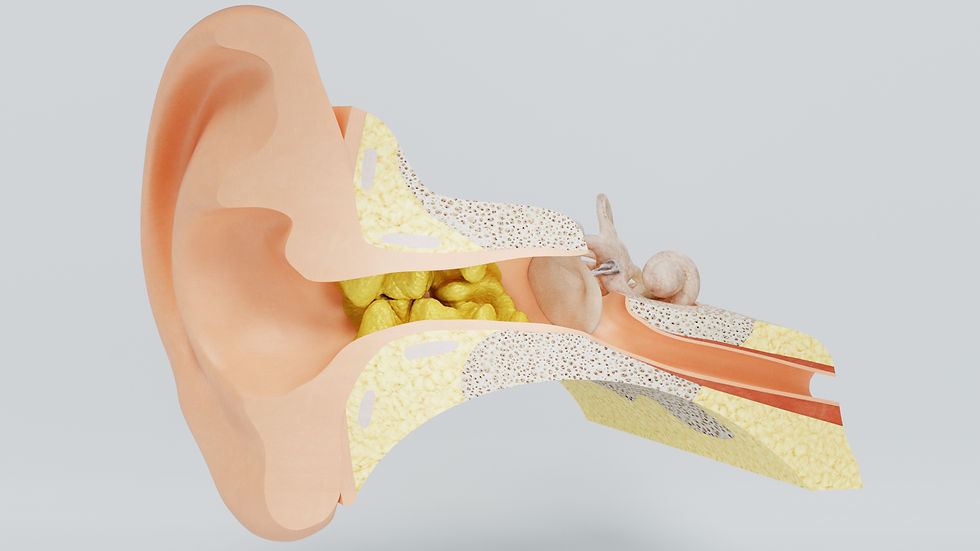Let's talk about earwax.
- Catherine Mills
- Nov 23, 2021
- 7 min read
Updated: Nov 14, 2023
When it comes to our ears, we often don't give them a second thought unless we have a problem with them. However, once we start to experience problems with our ears and hearing, only then do we realise how much impact these small organs have on our day to day life and we learn how important and complicated our ears really are.

If your hearing is normal, then it might be that a little wax in your ears may go unnoticed. However, with 1 in 6 people in the UK experiencing some degree of hearing loss, a little wax will only serve to compound the problem. In some cases worsening your hearing from what might only have been a mild loss to a more moderate loss and thus creating communication difficulties. It is estimated that on average, 2.3 million people a year in the UK have problems with earwax. However, as many people do not have regular examinations, it is likely this number is much higher. 'Impacted earwax is present in one in 10 children, one in 20 adults, over 30% of older people and more than 30% of people with learning disabilities' (Sevey & Singh 2019).
So, given the current climate, what should you do if you cannot make an appointment to have your ears assessed?
Patients are often advised to use drops. I recommend olive oil drops to soften the wax. Earol is a very good choice because it comes in a dispenser with a pump nozzle which is really easy to use. You can buy Earol in most chemists. It dispenses as a spray which gives better coverage of the wax compared to administering drops from a bottle as the drops can often pool in the ear canal floor. And whilst studies have been unable to show a preference for one type of drops over another, there is a general consensus that administering liquid into the ear in the presence of wax does help, certainly with it's removal.
Let me start by giving you a little bit of information about earwax and why we have it. The ear canal is, on average, 22.5mm long in adults. It is lined with hair follicles and also contains glands that produce a waxy oil called cerumen (earwax). Whilst too much earwax may cause problems for some, earwax does have some protective properties. It acts as a filter which prevents harmful things like bugs, sand and dirt from entering the ear and reaching our eardrum. It is also antimicrobial which means the earwax has substances in it that prevent infections from entering the body. In addition, the ear canal is self-cleaning which is why it is really important not to use cotton buds. The cotton is abrasive against the glands within the ear canal lining and can cause itching, bleeding and infection as well as pushing the ear wax further into the ear canal. This creates an added risk of damaging the ear drum (tympanic membrane) at the end of the ear canal.

If you've ever had wax removed from your ears, you will know that there are different methods that can be used. These are microsuction, syringing and removal using specifically designed dry removal tools. Whilst the gold standard and most common method now is microsuction, there is a place for each of these methods depending on a number of factors. The age of the patient, the consistency of the wax, whether the patient has learning difficulties, whether there is a perforated ear canal, whether the patient has an active ear infection or has suffered ear infections in the past, whether the patient has a middle ear implant, if they have an abnormal ear canal....the list really does go on. It is important to point out that all the methods are safe for your ears if conducted by a suitably qualified practitioner. Someone who explains to you fully and in a language you understand, what method they are using and why that is best for your ears.
A little about the different methods. Microsuction is one of the safest and most efficient methods for removing wax and uses a vacuum method rather than syringing. It can be a little noisy but is also very quick. Throughout the procedure, no contact is made with the eardrum. Syringing is a method that has been used for many years and many of you will have had this method at your local GP practice. Water is administered into the ear, sometimes manually and sometimes powered by an irrigation machine. The pressure of the water in effect washes the wax out of your ear. This method certainly poses risks as if the wax is too hard, the irrigation may perforate the ear drum. Conversely, if the wax is too soft, it is sometimes easier to irrigate the ear. As nearly all GP practices no longer provide ear wax removal, patients are now forced to private practices. What I find is that most still prepare the ear as they would for syringing, ie they use olive oil for a week or two before booking an appointment. One of the advantages of microsuction is that the preparation of the ear prior to the procedure is different. There is no need to use drops for 1-2 weeks. In fact, it is easier to remove the wax using the vacuum if the wax is a little harder. And I certainly use some olive oil during the removal to help if it's necessary. On occasion I will send someone away to use more oil and ask them to return but this is rare and certainly more rare than would be the case if you were softening wax sufficiently in order to have your ears syringed. Dry tools consist of specifically designed tools to help remove the wax, some are hooks. This is often the case for those who have wax very near the entrance of the ear canal which can be easily removed.
It is important to remember, as I said before, that all methods can be used, so long as the practitioner is qualified and experienced. And feel free to ask questions if there's anything you're not sure about. At Ear Sense, as with some other clinics, we use video otoscopy which allows the patient to see inside their ear (if they would like, it's not obligatory!) to see the blockage and then another examination afterwards so the patient can see their ear once the wax has been removed. It's a good way to show people the cause of the problem and then the resolution. I find patients like to know what a normal ear looks like too so landmarks can be shown and explained and any abnormalities identified and appropriate action taken if necessary.
Given that making an appointment is difficult at the moment, what should you do if your ears are blocked with wax or you feel your hearing is dull? And also what should you do if you have any other symptoms such as dizziness, tinnitus or pain?
My recommendation is to use olive oil in the first instance. If you are new to using drops, then Earol, as I suggested above, is a great place to start. It is important to say at this stage that if you know you have a perforated eardrum or have been told you might have a perforated eardrum then you should not put any drops of any description in your ears. If however, your eardrum is intact it is perfectly safe to use olive oil as it may help soften the wax. If there is no wax in the ear, it is reassuring to know that the olive oil can do no harm to your ears. I would recommend 2-3 drops twice daily for between 5 and 10 days and you should find some improvements. Don't be surprised if you feel a little more blocked to start with. Any small gaps in the wax will now be blocked with oil but over a period of time, some gaps will reappear as the wax is broken down allowing air and sound to travel through your ear. There are a lot of ear drops on the market, some will claim fast action clearing and express treatments but I would tread cautiously as some of the active ingredients in these drops can be quite aggressive in your ear and prolonged use can cause inflammation and itchiness and worse still, damage to your ear canal lining and eardrum.
A good tip....when you put the drops in your ears, pull your ear back and upwards away from your head. We all have natural bends in our ear canal and they are orientated slightly different from one ear to the other. Pulling "up and back" firmly ensures that you straighten the ear canal out which will enable the oil to reach the wax and not hit the wall of your ear canal. There is no need to use cotton wool or lie on your side for 10 or 15 minutes. Just wipe any excess with a tissue.
There are some syringing kits that you can buy from your local chemist. I would definitely approach these with caution. You might expect me to say this as a private practitioner but I do feel that if you cannot see inside your ears and they haven't been examined either, just be cautious about putting anything in there that may cause damage.
If you feel unbalanced or are experiencing some tinnitus then this may well be a symptom of your ear wax. For some patients, these symptoms are the first indicator that their ears need treatment. However, if they are new symptoms and they are causing any distress then I would strongly advise you make an appointment with your GP who may in turn make a referral to ENT (Ear, Nose & Throat). In addition, any sudden hearing loss, particularly in one ear only, warrants an appointment with your GP and most likely an ENT Consultant. If you would like to discuss your symptoms with me then please call or email and I will advise.
Whilst having a problem with your ears is not life threatening, it can certainly be life altering in so far as affecting a persons confidence and ability to listen and communicate with ease and accuracy. Ear wax is an easily remedied condition and some people find that drops on their own are enough to treat the problem. Going forward, it's not a bad idea to use some olive every month to keep the build up of ear wax under control. A couple of days of oil every month may really help and eliminate the problem at best and extend the time between appointments at worst.
For more information, advice or to make an appointment, please visit www.earsense.co.uk
At Ear Sense, we are continuing to follow Covid-19 protocols to offer the highest level of infection control for your safety.





Comments